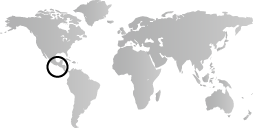Hunters roam the landscape, subsisting on large mammals and gathering plants and other natural resources. Incipient agriculture begins in about 5000 B.C., and over the next thousand years includes low-intensity crops such as chili peppers, avocados, and beans. Excavations in the Tehuacán valley in central Mexico have uncovered small cobs of Zea mays—maize, or corn—dated to around 3000 B.C. It probably has little nutritional value at this stage, but by 2000 B.C., corn is one of the staple crops of Mesoamerican society and remains so for thousands of years.
Mesoamerica and Central America, 8000–2000 B.C.
Timeline
8000 B.C.
6500 B.C.
MESOAMERICA
CENTRAL AMERICA
6500 B.C.
5000 B.C.
MESOAMERICA
CENTRAL AMERICA
5000 B.C.
3500 B.C.
MESOAMERICA
CENTRAL AMERICA
3500 B.C.
2000 B.C.
MESOAMERICA
CENTRAL AMERICA
Overview
Key Events
-
ca. 7000 B.C.
American Archaic cultures are those that occur between Paleoindian hunters and the peoples who have realized some combination of pottery making, burial mound construction, and garden technology. The combination varies from area to area.
-
ca. 5000 B.C.
Settlements are established on the shores of the resource-rich lakes in the Basin of Mexico, where early gardening efforts are undertaken.
-
ca. 4000 B.C.
Shell-mound sites are occupied in the coastal estuaries of the Soconusco region of the Pacific coastal plain of Mexico and Guatemala.
-
ca. 3114 B.C.
Mythic base date (August 13, 3114) of the Maya Long Count Calendar.
-
ca. 3000 B.C.
An early form of corn is identified in the Valley of Tehuacán in southern Puebla/northern Oaxaca states, and subsequently evolves into a highly productive plant food.
-
ca. 2800 B.C.
Ceramics of the Monagrillo complex are present in small settlements around Parita Bay in central Panama, an area of rich coastal resources. Technologically conservative, Monagrillo ceramics are made for many hundreds of years.
-
ca. 2300 B.C.
Tlapacoya (also known as Zohapilco), a significant island community on Lake Chalco in the Basin of Mexico, yields the earliest yet identified ceramic figurine in Mesoamerica.
Citation
“Mesoamerica and Central America, 8000–2000 B.C.” In Heilbrunn Timeline of Art History. New York: The Metropolitan Museum of Art, 2000–. http://www.metmuseum.org/toah/ht/?period=02®ion=ca (October 2000)
Related
Map
